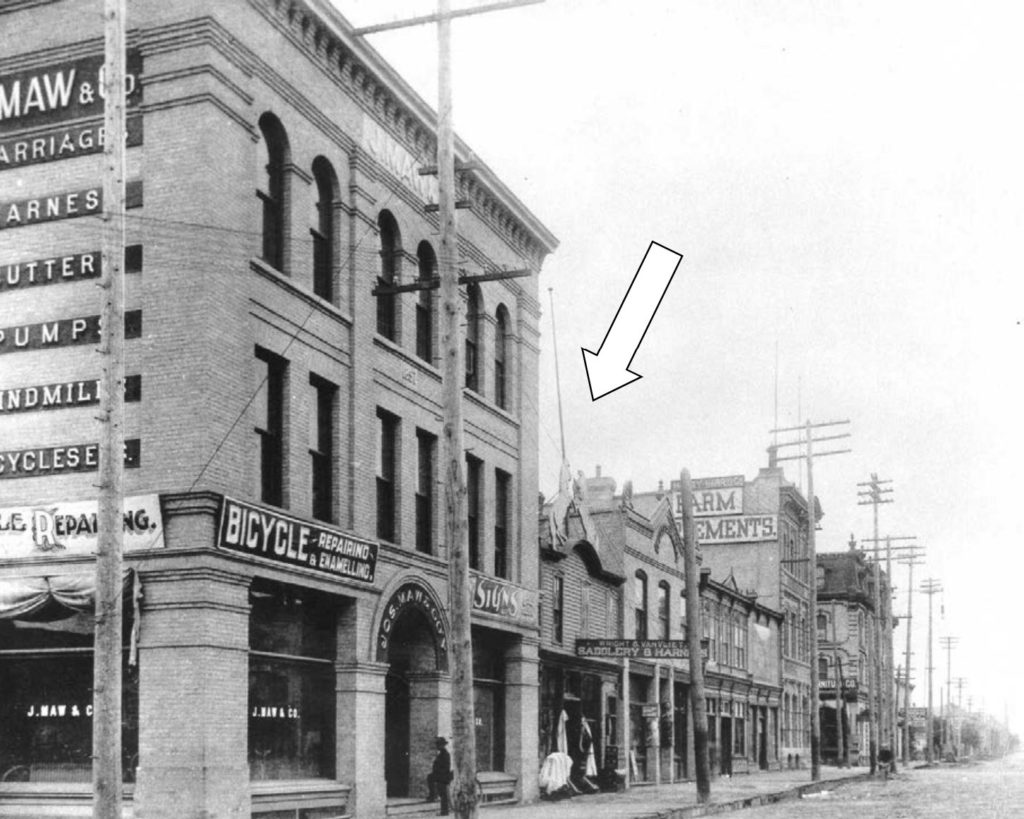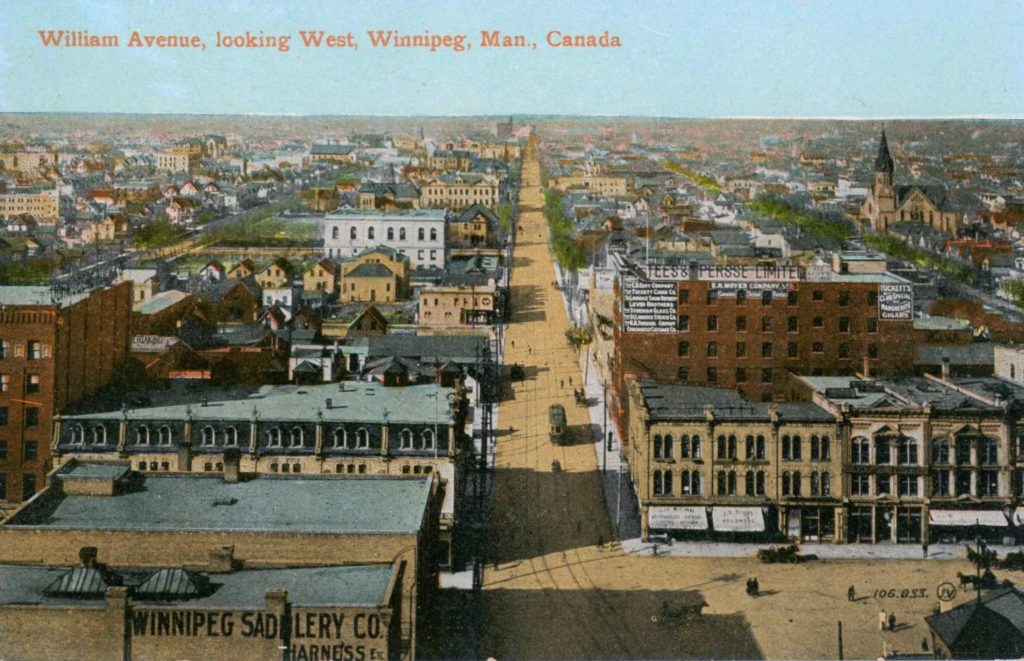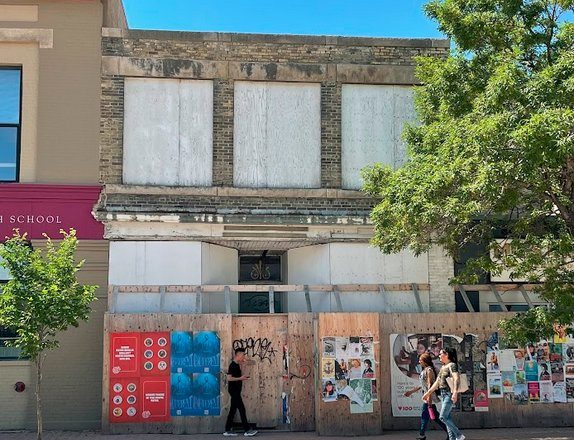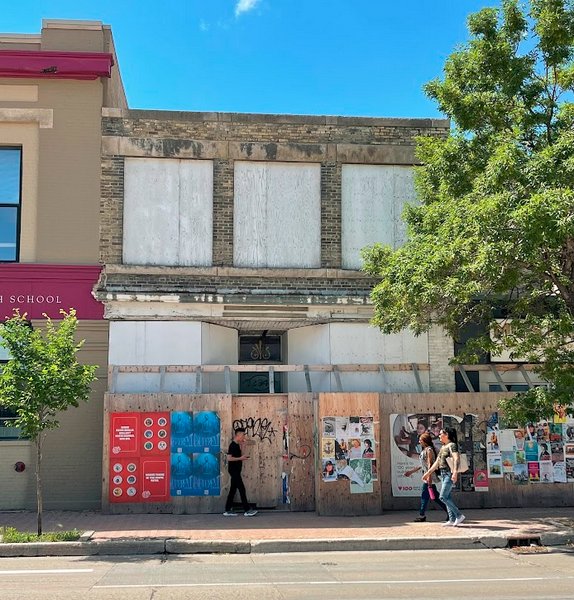
/ Blog
August 17, 2022
Unbridled Potential: The Winnipeg Saddlery Building
There is a boarded up brick building at 284 William Avenue, with a quaint alcove entrance and painted glass window above the doorway, looking out towards Winnipeg’s original Market Square. Known as the Winnipeg Saddlery Building, it was once part of a thriving commercial hub, surrounded by manufacturing company offices, the Grain Exchange, and a wide variety of shops. Now it sits across from the soon-to-be-developed Market Lands site, where the Public Safety Building once stood. But behind the walls of this neglected building is a story of resilience, adaptation and perseverance against the odds. After standing for nearly 120 years, the Winnipeg Saddlery Building is not yet ready to ride off into the sunset!
The building’s owner, Archibald Francis Wright, was born in Scotland in 1842 and immigrated to Canada in 1852 along with his parents, first settling in Montreal. As a young adult in Paisley (near Toronto, Ontario), Wright learned the harness manufacturing trade before moving south in the 1860s. He reached New Orleans by the time of the American Civil War (1861-1865) and made his fortune selling military supplies to the Confederate Army. Confederate and Union army members then began arrived in Winnipeg following the war, searching for new wealth or a fresh start.
Wright arrived in Winnipeg in 1869, where he started a harness and saddle shop, called A. Wright Saddler. But his work was soon interrupted, when six weeks after his wedding to Mary Ramsay in November of 1869, he was arrested by Louis Riel’s forces during the Red River Resistance. Following the Resistance, Wright was released from jail and resumed the operation of his shop on Main Street, near City Hall. He eventually partnered with Angus Arbuckle and renamed the company Wright and Arbuckle. In the late 1890s, Arbuckle left the business and was replaced by the company’s bookkeeper, Thomas A. Van Vliet. The business was renamed Wright and Van Vliet and moved from Main Street to a modest two storey building at 284 William Avenue, overlooking Winnipeg’s original Market Square.

Wright and Van Vliet’s shop on William Avenue circa 1901.
Source: Archives of Manitoba in the City of Winnipeg Report
Winnipeg was a booming young city at the beginning of the 20th century and success came quickly at the new location for Wright. He renamed his business once again, this time changing it to the Winnipeg Saddlery Company. With a new name came a new building, constructed in 1903. The two-part commercial style Winnipeg Saddlery Building was by designed the prolific architect James H. Cadham, once again located at 284 William Avenue. The five-storey building was constructed with a rubblestone foundation, while the substructure was built of clay brick. Unfortunately, these elements have contributed to the structural instability present in the building since construction was completed. Metal rods in combination with wooden beams were used on all floors for strength, an unseen feature that is truly unique to the structure. The dirt floor basement would have contained leathers and oils; the first floor would have functioned as a general store, the second floor stored hardware and leather, while the third was used for leather and sweatpads. The upper two floors were used as work spaces.

The sign on the side of the Winnipeg Saddlery Building can be seen in the lower left corner of this postcard, dated between 1908 and 1913.
Source: PastForward Winnipeg
The now weathered brick exterior of the Winnipeg Saddlery Building is highlighted by a cornice at the center of the facade and distinguishes the ground floor from the simplistic second floor. This architectural detail created a visual separation between the two storeys. As rebuilt in 1936, the first-floor large display windows provided an opportunity for retail to be showcased and entice those walking by the shop to come in and peruse. This intentional characteristic was only heightened by the recessed entrance that creates the central focus of the facade. The second floor continues a similar window pattern, as it was designed with three large square-headed windows that allowed natural light to cascade throughout the space. The flat roof was finished with brick corbelling and suggested a modern interpretation.

The Winnipeg Saddlery Building in 1915, facing Winnipeg’s original Market Square.
Source: Murray Peterson Collection in the City of Winnipeg Report
Much of the original structure of the Winnipeg Saddlery Building was damaged by a fire in 1906. According to reports, the fire started accidentally after a boy stepped on a match, striking it in one of the lower levels of the building and spreading fast. The fire began to race up the stairwell, forcing eighteen of the nineteen employees in the building onto the roof of the Winnipeg Saddlery Building. Fortunately, Fire Hall No. 1 was less than a block away, allowing firefighters to arrive on the scene quickly. So did a crowd of onlookers, braving the cold December weather to huddle together at Market Square. All nineteen men were saved from the building, and the blaze itself was soon extinguished. According to the Winnipeg Telegram, “the blaze was not extraordinary, being easily fought. The only flames visible at any time burst from the rear of the top story.”
Damage to the building cost around $20,000, while the fire damaged something near $60,000 in goods. There was another problem: the building lacked exterior fire escapes, which did not escape the notice of the chairman of Winnipeg’s Fire, Water and Light Department, Alderman James Cunningham Gibson. An investigation after the fire revealed that the building owner had been notified twice about the need for an exterior fire escape but had not yet installed one. No prosecution followed, and the Winnipeg Saddlery Building was repaired shortly afterwards.
Wright continued to run the company until he died in 1912. Then his wife Mary Wright (nee Ramsey) took over as president of the Winnipeg Saddlery Company – a position she held until her death, at age 90, in 1939. A.M. Bannerman was hired to manage the business, and under his tenure, the Winnipeg Saddlery Building would see significant renovations in 1936.
This new 1936 facade is the one we still see today, with its recessed entrance flanked by vast window displays. Rough-cut stone stills embellish the window openings, and the roof was finished with brick corbelling. It looked good on the outside, but the building was plagued with structural problems. City reports from the late 1930s show issues with floor heaving, masonry cracks, and a leaking roof. Concrete piles were added in 1945 to help shore up the building, and by 1962 the top three floors were removed. Unfortunately, this seems to have done little to help, as by 1961, it was reported that only the first floor of the building was in use.
Bannerman split the business into two sections in 1945, Farm Equipment and Seed Ltd. and Winnipeg Saddlery Ltd. The seed company was taken over by J. Jones and Sons in 1949, and the saddlery business closed in 1955, leaving the Winnipeg Saddlery Building. The building sat vacant for three years until Abraham Dreman purchased the building in 1958 for the Logan Mail Order Company. The building was then occupied by garment manufacturers, first Dreman and then Sam and Harry Reiss’s Reiss Furs and Fine Fashion in the early 1990s.
The Winnipeg Saddlery Building has sat vacant since the early 2000s due to structural concerns, and in 2012, the building was partially boarded up due to neglect. Following this, the owner received a notice that the structure needed to be secured appropriately and have a boarded building permit to comply with the Vacant Building Bylaw. Despite this, the building was left unrepaired, thereby disregarding the community’s safety and putting the structure at risk of demolition by neglect – even though its protective heritage designation is intended to prevent demolition. Vacant buildings attract criminal behaviour, are at much higher risk of fire and erode the value and safety of the surrounding neighbourhood. In the case of built heritage, such as the Winnipeg Saddlery Building, there is also the loss of a community’s heritage, important landmarks, affordable spaces and environmental suitability. Vacant buildings are very problematic and it are becoming all too common in our city. Heritage Winnipeg has been advocating to the City for better enforcement, and to try and discourage this behaviour with much higher financial costs including higher taxation to the owners, therefore encouraging rehabilitation or divestment.

The vacant Winnipeg Saddlery Building in April 2004.
Source: Virtual Heritage Winnipeg
Since then, CentreVenture, an arms-length agency of the City of Winnipeg, whose mandate is to provide leadership in the planning, development, coordination, and implementation of projects and activities downtown, purchased the Winnipeg Saddlery Building to prevent its demolition. CentreVenture has worked diligently to stabilize the structure. As of spring 2022, the foundation, basement and interior structural restorations have been completed, with the exterior next on the list. The president and CEO of CentreVenture, Angela Mathieson, says that CentreVenture “purchased the building in order to have it stabilized structurally.” To achieve this, a new structural system was constructed from the inside of the building. She says that CentreVenture’s goal is to “stabilize the building and to get it back into a shape where somebody could either lease it or purchase it from us and occupy it in the future.” This will allow for the future tenant(s) to have program flexibility depending on their desires for the space. CentreVenture is motivated to sell or lease the property once construction has been completed.
Despite the challenges that the Winnipeg Saddlery Building has experienced over the decades, this unique building has been an essential component of the William Avenue streetscape for over 100 years. Additionally, it contributes to Winnipeg’s Exchange District’s diversity, economy, vibrancy, and history. When the improvements are completed, the Winnipeg Saddlery Building will remain a part of our story for decades to come. Heritage Winnipeg applauds CentreVenture for working to conserve and revitalize this one of a kind heritage building, and looks forward to it fulfilling its potential, serving the community once again.
THANK YOU TO THE SPONSOR OF THIS BLOG POST:

Written by Heritage Winnipeg.
SOURCES:
Angela Mathieson, CEO of CentreVenture - interviewed on July 22, 2022
Archibald Wright, Manitoba Historical Society
City of Winnipeg Historical Report, 284 William Avenue
James Cadham, Manitoba Historical Society
Planning with Purpose – Fire Hall No. 1
Winnipeg Downtown Places: 284 William Avenue
Winnipeg Saddlery Building (284 William Avenue), Manitoba Historical Society













